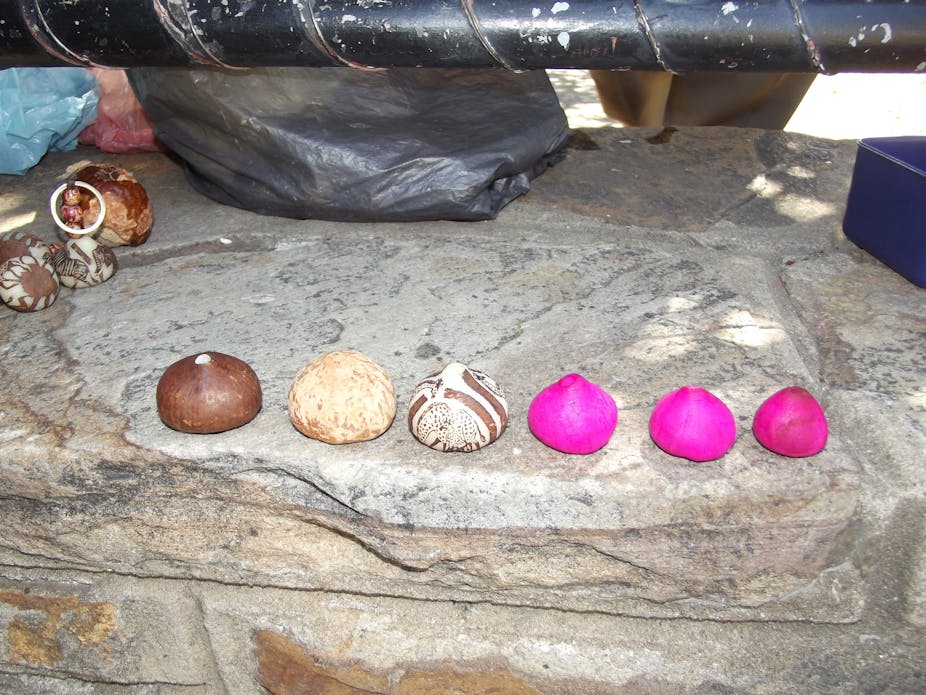The name Makalani is a nickname given to a tall species of palm tree – the Hyphaene petersiana – by the local people living in the north-western parts of Namibia. The meaning of the name Makalani is difficult to trace, but has generally been adopted across Namibia. Also known as the vegetable ivory palm, the tree can bear up to 2,000 fruit over four seasons – each fruit housing a nut. Harvesting the hard, ivory-coloured seed doesn’t harm the tree.
The nuts are soft enough to shave away with steel tools yet hard enough to retain delicately carved detail. They can also be polished after being carved without losing the detail. These properties mimic those of ivory or shell which are used to make valued objects like cameos and buttons.
Objects made from the nuts are sold to tourists in Namibia and provide a valuable source of income in a country that struggles with high levels of unemployment.
And, as the example of the similar Tagua nut (the seed of the Phytelephas aequatorialis palm) in Ecuador shows, there is a rising demand for these products. This includes add-ons, like buttons, for the fashion industry. Called vegetable ivory, the Tagua nut can be shaped into buttons for fashion garments. Additional design features could include minor detailing in car interiors.
In my research I found that several other crafting techniques used on the Ecuadorian nut could also be used on the Makalani nuts too.

I partnered with a master crafter in a local community of Makalani crafters to establish a project to look at ways of developing the artisan craft based on rich indigenous knowledge. As an academic jewellery designer, I was able to offer different jewellery techniques. The master crafter’s indigenous knowledge was used to understand the material and what techniques worked best when carving the nut.
The project raised interesting questions about the use of indigenous knowledge and commercialisation.
Research through experiments
We experimented with various classic jewellery design techniques. These included sanding or dyeing of the material with locally accessible dyes. These dyes included vegetable dyes (beetroot) and a bright pink (magenta) dye known as Otjize. Otjize is a natural dye used to dye shells and fabric by the Oshiwambo women.
The Oshiwambo tribe live mainly in the northern part of Namibia. The colour of their traditional dress, known as an Ondelela, creates a distinct aesthetic. This dye is shrouded in mystery as none of the women could (or perhaps wanted to) share what the dye was made from.
The experimental sessions proved a great success. Many of the artisans were excited to learn more about the new techniques. Many had never seen the nuts dyed.

But I was concerned about the project’s inevitable impact on the social fabric of the communities. I questioned whether local crafts would not eventually dissolve when organised like an industry.
The master crafter voiced his concern around the exclusion of the crafters from the commercialisation of their craft. The development of their craft had resulted in marginalisation in the past.
To make such a co-creation project work, it was important that there wasn’t a hierarchy between the local crafters and myself. This helped establish trust and created an environment of learning through experimentation.
Each step was carefully documented. Great attention was paid to details that enabled a better understanding the needs of the craftsmen, and incorporated their suggestions. This helped to avoid the trap of bringing “design solutions” to a “local problem”.
But, for me, questions remained. Would gearing the art towards mass commercialisation threaten the craft practices which form the very essence of the indigenous knowledge embodied in their artefacts?
I was reassured by advice from Thomas Thurner, Research Chair for Innovation in Society at Cape Peninsula University of Technology:
Studies like this one provide valuable insights into how co-creation between indigenous knowledge and academic knowledge could work. Marrying both could yield new ways of making things work both in a sustainable manner and with a high social acceptance.
Is more really better?
Today the crafted product is being developed in its local setting, which is based on the crafters’ skills. One unresolved question was whether or not to pursue commercialising the crafters’ operations. The possibility of moving to manufacturing products was not something the crafters had entertained.
Rising production numbers would require industrial production methods. But this, in turn, would lead to the unavoidable detachment between the crafter and the final product. The most important question for the crafters was how to retain most of the benefits of sharing their indigenous knowledge, and how to ensure that they remained a crucial (and lucrative) part of the process.
Opening a commercial route would bring about an additional benefit – saving a depleting tree population. The north-central part of Namibia used to be dense with palms but many have been lost because of a rise in palm sap harvesting.

